昔から使われてきた生活雑貨から見える循環型社会における課題/ Encouraging a recycle-based society through old houseware items/ 从古来使用的生活杂货看循环型社会的课题
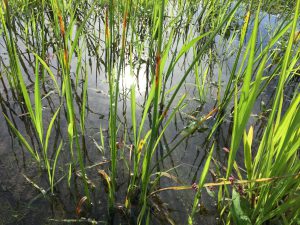
日本の高温多湿な風土の中で培われてきた草履を作るお百姓さんが、四国にもいることを聞き、取材で訪問した。達痲工房の寺田さんは、香川と徳島の県境集落で、注文を受けて編んだオーダーメイド草履を全国のお客さんに販売しながら、お百姓さんを続けている。
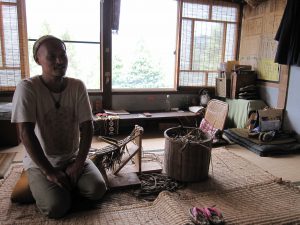
四国内で、自身で七島いを育てながら草履を編むことを生業にしている人は、彼だけだと聞いた。七島いは、カヤツリグサ科でシチトウ(別名リュウキュウイ)という。古代、エジプトの紙などにも使われる「パピルス」の仲間で、古くは現在のトカラ列島で栽培され、栽培用として国内に持ち込まれ普及したのが始まりと言われている。
通気性が良く、摩擦摩耗にも強く、使い込むほどに美しい艶が出るのが特徴で、琉球畳の畳表や仏間の畳、柔道畳などで使われていた。そんなシチトウは、い草や化学繊維の導入で需要が減るとともに、海外からの安い原料輸入の影響を受け、現在、日本国内での生産はもはや風前の灯火となっている。主な生産地の大分県においても、高齢化等の影響で生産の継続が年々厳しくなっている。
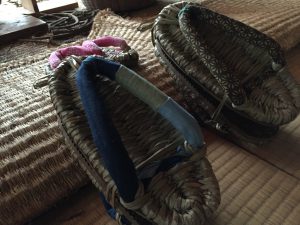
そんな希少草履の耐久性は2年程とのこと。鼻緒や靴底のメンテナンスを行いながら、除々に足に馴染んだ草履を長く大事にはく。天地の恵みをふんだんに受けた草履は、現代の靴に自分の足を合わせるのとは、逆の発想である。
SDGs(持続可能な開発目標)にある、生産と消費が注目されている。草履生産と消費サイクルにおいて、持続可能性の実現が難しい状況にありながら、寺田さんは何とかこの生業を基軸とした百姓生活の持続可能なものにするため、挑戦を続けている。
市民のライフスタイルや消費の変化が、どこまでその挑戦に答えることができるのか。草履の事例だけでなく、さまざまな伝統文化の継承においても同じ課題を抱えていることを改めて実感した。
■Encouraging a recycle-based society through old houseware items
Ehime Global Network went to interview a farmer, Mr. Terada, who makes custom-made zori (Japanese traditional sandals) for customers all around Japan, while still doing his farmer’s job in a village located on the border between Tokushima and Kagawa prefectures. He is the only man in Shikoku who grows Nanashima rush – a type of plant in the family of grasses – and makes zori to live. The rush is scientifically called Cyperus monophyllus Vahl and it is in a same category with papyrus which was used in ancient Egypt. The rush was grown in Tokara archipelago and brought into the Japanese mainland for cultivation later. The rush is used to make surface of Ryukyu-Tatami, and tatami floorings for use in Buddhism rooms, judo areas, etc. because of its high air permeability, high resistance to frictional wear and a feature which it gets a more beautiful luster the longer you use it. The production of Nanashima rush in Japan is now in severe decline due to reduced demand caused by synthetic fibers and cheap import material. It gets harder and harder to produce the rush even in Oita, the main production area.
The durability of the rare zori is around two years. Wear a pair of zori for a long time with care and maintenance of the thong and the sole so it gets to fit and become a part of your body. Wearing the zori with the favor of Mother Nature is a completely different idea from fitting modern day shoes.
Production and consumption are on SDGs and getting more and more attention today. The situation of the circle of zori production and consumption doesn’t look great to achieve sustainability but Mr. Terada keeps trying to make his farming life sustainable.
How much the change of people’s lifestyle and consumption can answer the challenge? I realized not only zori but every other tradition and their inheritance faces a similar problem.
■从古来使用的生活杂货看循环型社会的课题
听说四国也有制作日本高温潮湿的风土培育出来的草鞋的农人,于是去采访了他。达麻工房的寺田先生,在香川县和德岛县境的村落里一边接受订单、编织定制草鞋、向来自全国的客人们贩售,一边继续务农。
据说,他是四国唯一自己种植茳芏并且以编织草鞋为生的人了。茳芏读作jiāng dù,跟古埃及草纸使用的纸莎草「papyrus」同属莎草科,古时现今的吐噶喇列島有栽培,带到国内栽培后开始普及。
因其具有通气性好、不易磨损、越用越有光泽的特征,常用于琉球榻榻米的表面、佛堂的榻榻米及柔道榻榻米。由于化学纤维的引进,茳芏的需求减少,同时,受到海外原料价格低廉的影响,日本国内的生产已经近乎绝迹。主产地大分县也因高龄化影响,形势一年比一年严峻。
如此稀有的草鞋,有两年左右的耐久性。细心养护草屐带和鞋底,让草鞋逐渐与脚相合,就能穿上很久。草鞋踏受天地恩惠,与符合自己脚大小的现代鞋履相比,可以说是相逆的概念了。
由于符合可持续发展目标,草鞋的生产和消费受到了瞩目。尽管要想实现其循环持续,现状还很艰难,但寺田先生无论如何也坚持面对挑战,坚持以此为基础的农民生活。
市民的生活方式、消费的变化,应对这样的挑战,能走到哪一步呢。不仅仅是草鞋一例,近来感到各种各样的传统文化都面对着相同的课题。
愛媛の高校生グループwakuwaku-youthのグローカルな取り組み/ Glocal Activities by Waku Waku Youth, a group of high school students in Ehime/ 爱媛县高中生组织wakuwaku-youth的全球本地化实践
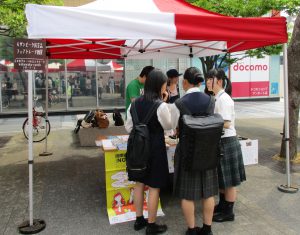
2016年から2030年までの15年間を期間に世界中で取り組む、「SDGs(持続可能な開発目標)」。目標達成のためには、地域ごとの持続可能な社会づくりに向けた活動の積み重ね、多様な世代の参画が不可欠だ。
2017年3月、SDGsをキーワードとし、自分たちにできることを地域で実践することを目的に、高校生グループ「wakuwaku-youth(わくわくユース)」が発足した。
発足メンバーは愛媛県内の高校生7名。ユースにできることを模索し、国際・環境・教育など多岐にわたるグローカルな問題の解決をめざし、ユース同士が学びあい、育ちあう場づくりに取り組んでいる。
3月にグループが発足して以降、特に注目しているテーマは「フェアトレード」だ。フェアトレードは、生産者に配慮した公平な貿易のことで、SDGsの目標1「貧困をなくそう」、目標12「つくる責任、使う責任」などに関連しているとともに、近年四国内でも関心の高まっている「エシカル消費」、「思いやり消費」などの理念とも関連が深い。
そこで3月末には、日本国内で3番目のフェアトレードタウンに認定された神奈川県逗子市を訪問。自治体や市民活動団体が連携したまちづくりの取り組みについて、逗子フェアトレードタウンの会の協力を得て、逗子市長、逗子市在住のユースとの意見交換を実施した。
さらに、昨日5月21日に香川県高松市で行われた「さぬきマルシェinサンポート」と連携して開催された「フェアトレードまつりinかがわ」へ参加。フェアトレード商品の販売体験、来場者へのインタビュー調査等を実施し、フェアトレードのPR活動を行った。また、同イベントに出展していた地元香川の高校生・大学生との交流を通して、ユース同士で学びあいを深め、今後の活動に繋がる大きなヒントを得た。
グループ発足後、ESD、SDGsなどのグローバルな視点を学びつつ、自分たちが暮らす地域で足元から実践できることを模索し続け、現在では新たな活動にチャレンジし始めている。
今後は、フェアトレード商品販売促進として、モザンビークの女性の自立支援につながる「くるみボタンのヘアゴム」を愛媛県内の美容院で販売できるよう、フェアトレードやヘアゴムについて説明した小冊子を作成し、店舗への協力を呼びかける予定だ。
持続可能な社会づくりに向けたwakuwaku-youthのグローカルな活動に、今後も注目していきたい。
■Glocal Activities by Waku Waku Youth, a group of high school students in Ehime
“Sustainable Development Goals” (SDGs) is an international program scheduled to operate from the years 2016 to 2030. It is essential for achieving these goals to do continuous activities to create the sustainable society in each region and the involvement of variety of generations.
In March of 2017, seven high school students from Ehime began a group called “Waku Waku Youth,” whose keyword is “SDGs” and whose goal is to do what they can in their local area. They are trying to create a place where youth can learn and educate each other in order to look for what youth can do with their capability and solve glocal problems like international relations, education deficits, environmental challenges, etc. “Fair trade” is one of the themes they’ve been focusing on since the start of the group. Fair trade is a trading method with fairness and consideration for producers. Fair trade is related to the goal #1, “No Poverty”, goal #12 “Responsible Consumption and Production,” and some more SDG goals and also has deep connection with the ideas of “ethical consumption” and “thoughtful consumption” which is getting more attention in Shikoku recently.
At the end of March, they visited Zushi Kanagawa, the third city to be qualified as a fair trade town in Japan. With the help of Fair Trade Town Zushi, they met and discussed about city development with local government and a citizens group, with the mayor of the city, and young people. They also took part in the “Fair Trade Festival in Kagawa” held in cooperation with “Sanuki Marchais in Sunport” in Takamatsu, Kagawa, on May 21. Waku Waku Youth sold fair trade goods and interviewed about fair trade to visitors. They also had a chance to talk to local students and deepened their thoughts so they could gain a clue to keep their activities well. They have learned global concepts like ESD and SDGs and have been trying to find things they can do locally since the launch of the group. One new activity is to make a booklet which explains fair trade. One example they will give are the hair bands with large embroidered buttons on them that are handmade by village women in Mozambique. This participation in the small-scale economy helps Mozambican women to be independent yet productive. Waku Waku Youth has requested of barber shops in Ehime to sell these hair-bands in their shops.
The glocal activities of Waku Waku Youth to create a sustainable society are remarkable.
■爱媛县高中生组织wakuwaku-youth的全球本地化实践
从2016年到2030年的这15年间,为了在全世界实现「可持续发展目标(SDGs)」,各地方的可持续发展社会创建活动责任重大,不同年龄段的参与都不可或缺。
2017年3月,以可持续发展作为关键词、以在地方做力所能及的实践为目的、高中生组织“wakuwaku-youth(わくわくユース)”创立了。
创始成员是爱媛县的7名高中生。他们朝着解决国际、环境、教育等多方面的全球本地化问题的方向,摸索少年力所能及的事情,致力于建设青少年们共同学习、共同成长的一片天地。
自3月成立以来,特别引起注目的一个主题叫“公平贸易”。公平贸易关怀生产者,与可持续发展的目标1“无贫穷”、目标12“责任生产、责任消费”等关连,与近年四国内关注度也很高的“道德消费”“关怀消费”等理念亦关系匪浅。
3月末,他们访问了日本国内第三个被认定为公平贸易城市的神奈川县逗子市,在逗子公平贸易城市协会的协助下,就建设自治体及市民活动团体协作的城市相关与逗子市市长和当地青少年交换了意见。
不仅如此,他们还参加了5月21日于香川县高松市举办的、由「Sanuki Marche in Sunport」协办的“香川公平贸易节(Fair Trade Festival in Kagawa)”,体验了公平贸易商品的贩售,进行了来场者问卷调查,开展了公平贸易的宣传活动,并且与参加同活动的香川本地的高中生、大学生交流,加深了青少年间的共同学习,收获了关于今后活动的重要启示。
组织成立后,他们也不断学习着ESD、SDGs等全球本地化视点,继续摸索着立足于所在地、有可行性的活动,现在还开始了新的挑战。
今后,作为促进公平贸易商品贩售的一部分,为了在爱媛县内的美容院里贩售支援莫桑比克女性自立的「胡桃木纽扣发圈」,他们打算制作公平贸易与发圈相关的说明小册子,呼吁来自店铺的支持。
wakuwaku-youth致力于建设可持续发展社会,今后也请关注他们的全球本地化活动。
徳島県神山町から始まったアドプト・プログラム/ Adopt Program started from Kamiyama, Tokushima/ 发端于德岛县神山町的领养计划
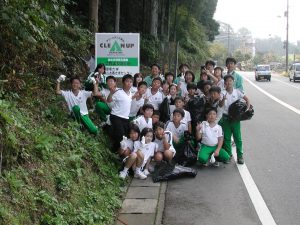
全国に広がっている、住民や企業が道路や川の管理を行う「アドプト・プログラム」。日本で初めて導入されたのは、徳島県神山町だ。町内に拠点をおく4つの民間団体が、1998年6月に道路のゴミ拾いを初めて開催し、今年で20年になる。きっかけは、グリーンバレーの理事長である大南氏がアメリカを訪れた時、カリフォルニアの高速道路で、道路の清掃を企業が行う「アドプト・ア・ハイウェイ」の標識を見て、このような仕組みは将来必ず日本でも必要になると直感したことからはじまる。
そのころ、神山町では国際交流協会が立ち上がり、環境と芸術の2つの柱で町を活性化しようという動きができていた。この環境の柱に、アメリカで効果を発揮しているがまだ日本で取り入れられていないアドプト・プログラムを据えた。道路にごみが落ちていないことをひとつの文化の表現にしようとした。
取り組みを始めるために提案に行くが、道路法の規定によって企業団体名入りの看板は立てられないとのことだった。いろいろ手を尽くしてみたが前に進まないので、自主活動としてスタートした。自主的にスポンサー名を入れた看板を立て、住民が2か月に1回、町内の国道や県道の掃除を始めた。
活動開始から1年ほど経った頃から、看板の設置費用については県の協力が得られるようになり、ごみ拾いは住民ボランティアで行う仕組みとして整い、1999年10月「徳島県OURロードアドプト事業」が生まれた。その後、瞬く間に全国46都道府県に広がり、今では374自治体、約500のプログラムに250万人以上が参加(2016年3月末現在、公益社団法人食品容器環境美化協会調べ)する大きなパートナーシップの取り組みとなっている。
■Adopt Program started from Kamiyama, Tokushima
The “Adopt Program,” in which local people or companies take care of their roads and rivers, is now widely spread around Japan. The very first town to adopt that program was Kamiyama, Tokushima. Twenty years ago, in June of 1998, four citizens’ groups held a cleanup campaign for the first time. The cause of this program is when Mr. Ominami, the board chairman of Green Valley, saw California’s “adopt a highway” program which companies clean stretches of highway. He realized that this kind of system would be necessary in Japan soon.
At that time in Kamiyama, the International Communication Association was formed and a new movement to revitalize the town with art and environment had just begun. The “Adopt Program,” which was very successful in the USA but no adaptation in Japan, was set to be the core of the environment project. They wanted to make trash-free streets as a way of cultural expression. Green Valley proposed the project to the local government but the government declined funding of road signs with a company’s name on them. In response, the group started their own project. They themselves built road signs with sponsors’ names on them and local people volunteered to clean up streets around the town every two months.
In October 1999, about a year after the program started, they finally got support from the prefectural government for road signs and the clean-up project became an ordered program called “Tokushima OUR Road Adopt Project.” This program quickly spread to 46 other prefectures across Japan. There are partnerships by 374 municipalities and over 2.5 million participants with around 500 programs (according to The Beverage Industry Environment Beautification Association).
■发端于德岛县神山町的领养计划(Adopt Program)
领养计划(Adopt Program)指的是由当地居民或企业负责管理道路河流的企划,现已在日本全国展开。最初引进的是德岛县神山町——1998年6月,町内的4家民间团体第一次开展了捡拾道路垃圾的活动,距今已经20年。追本溯源,Green Valley理事长大南氏访问美国时,在加利福尼亚州的高速公路上看到了企业负责清扫道路的“Adopt A Highway”(领养一条高速公路吧!)标语,直觉感到日本未来也必然需要这样的企划。
当时,神山町创立了国际交流协会,确定了以环境和艺术为两大支柱、营造城市活力的动向。这样的环境支柱,即为美国卓有成效却尚未引入日本的Adopt Program。路无垃圾,是一种文化的表现。
相关提案应运而生,然而根据道路法规定,不能设立印有企业团体名称的看板。多番尝试无果后,Adopt Program作为自发活动启动了。居民自发设立印有赞助商名称的看板,开始每两个月清扫一次町内的国道和县道。
活动开始1年后,在县里的协助下,解决了设置看板的费用,也成立了捡垃圾的居民志愿者组织。1999年10月,“德岛县OUR ROAD领养事业”诞生了。此后瞬间推广到了全国46都道府县、今天的374个自治体,成为了拥有500个企划、超过250万人参与(2016年3月末,公益社团法人食品容器环境美化协会调查结果)的伟大的合作实践。



